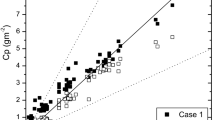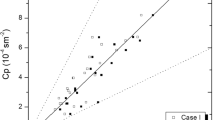Abstract
In this work, an analytical solution for the steady-state fractional advection-diffusion equation was investigated to simulate the dispersion of air pollutants in a finite media. The authors propose a method that uses classic integral transform technique (CITT) to solve the transformed problem with a fractional derivative, resulting in a more general solution. We compare the solutions with data from real experiment. Physical consequences are discussed with the connections to generalised diffusion equations. In the wake of these analysis, the results indicate that the present solutions are in good agreement with those obtained in the literature. This report demonstrates that fractional equations have come of age as a decisive tool to describe anomalous transport processes.
Similar content being viewed by others
References
P Wagle, T H Skaggs, P H Gowda, B K Northup and J P S Neel, Agric. For. Meteorol. 285, 107907 (2020)
M J Schmidt, S D Pankavich and David A Benson, Adv. Water Resour. 117, 115 (2018)
O C Acevedo, L Mahrt, F S Puhales, F D Costa, L E Medeiros and G A Degrazia, Q. J. R. Meteorol. Soc. 142(695), 693 (2016)
M T Vilhena, D Buske and T Tirabassi, Atmos. Res. 92, 1 (2009)
D Lu, A R Seadawy, M Arshad and J Wang, Res. Phys. 565, 1 (2017)
A R Seadawy, Physica A 455, 44 (2016)
A R Seadawy, Physica A 439, 124 (2015)
A R Seadawy, Comput. Math. Appl. 67, 172 (2014)
E S Selima, A R Seadawy and X Yao, Eur. Phys. J. Plus 131, 425 (2016)
Y S Özkan, E Yaşar and A R Seadawy, J. Taibah Univ. Sci. 14, 585 (2020)
H Ahmad, A R Seadawy, T A Khan and P Thounthong, J. Taibah Univ. Sci. 14, 346 (2020)
P Kumar and M Sharan, Proc. R. Soc. A 466, 383 (2010)
A Giusti, J. Math. Phys. 59, 013506 (2018)
R S De Quadros, G A Gonçalves, D Buske and G J Weymar, Defect Diffus. Forum 396, 91 (2019)
M Sharan and M Modani, Atmos. Environ. 40, 3469 (2006)
E Demael and B C Carissimo, J. Appl. Meteorol. Climatol. 47, 888 (2008)
P Kumar and M Sharan, Atmos. Res. 106, 30 (2012)
M Sharan and P Kumar, Atmos. Environ. 43, 2268 (2009)
D M Moreira, M T Villena, D Buske and T Tirabassi, Atmos. Res. 92, 1 (2009)
A G Ulke, Int. J. Environ. Pollut. 55, 113 (2014)
K S M Essa, S E M Elsaid and F Mubarak, J. Atmos. 1(2), 8 (2015)
B Sportisse, Fund. Air Pollut. 1, 93 (2010)
P Kumar and M Sharan, Environ. Model. Assess. 19(6), 487 (2014)
S K Singh, M Sharan and J P Issartel, Bound-Lay. Meteorol. 146(2), 277 (2013)
S Wortmann, M T Vilhena, D M Moreira and D Buske, Atmos. Environ. 39, 2171 (2005)
D A Benson, S Pankavich and D Bolster, Adv. Water Resour. 123, 40 (2019)
A Giusti, Fract. Calc. Appl. Anal. 20(4), 854 (2017)
E Y Vitokhin and E A Ivanova, Contin. Mech. Therm. 29(6), 1219 (2017)
S Vitali and F Mainardi, AIP Conf. Proc. 1836, 020004 (2017)
B J West, Rev. Mod. Phys. 86, 1169 (2014)
S Vitali, G Castellani and F Mainardi, Chaos Solitons Fractals 102, 467 (2017)
I Podlubny, R L Magin and I Trymorush, Fract. Calc. Appl. Anal. 20(5), 1068 (2017)
I Podlubny, Fract. Calc. Appl. Anal. 22(6), 1502 (2019)
B Datsko, I Podlubny and Y Povstenko, Mathematics 7(5), 433 (2019); I Podlubny, Fract. Calc. Appl. Anal. 5, 367 (2002)
J T Machado, F Mainardi and V Kiryakova, Fract. Calc. Appl. Anal. 18(2), 495 (2015)
X-J Yang, F Gao and H M Srivastava, Comput. Math. Appl. 73(2), 203 (2017)
X-J Yang, F Gao and H M Srivastava, J. Comput. Appl. Math. 339, 286 (2018)
J T Machado, A M S F Galhano and J J Trujillo, Scientometrics (JCR) 98(1), 577 (2014)
D Buske, B Bodmann, M T Vilhena and R S De Quadros, Am. J. Environ. Eng. 5(1A), 1 (2015)
R B Smith, Bound.-Lay. Meteorol. 139, 501 (2011)
R Gorenflo, Y Luchko and M Yamamoto, Fract. Calc. Appl. Anal. 18(3), 799 (2015)
A Chechkin, F Seno, R Metzler and I M Sokolov, Phys. Rev. X 7(2), 021002 (2017)
R Gorenflo and F Mainardi, Appl. Phys. 45, 1 (2019)
R Gorenflo and F Mainardi, Appl. Phys. 99, 1 (2019)
V Kolokoltsov, Fract. Calc. Appl. Anal. 18(4), 1039 (2015)
E M Hernndez-Hernndez, V Kolokoltsov and L Toniazzi, Chaos Solitons Fractals 102, 184 (2017)
R Gorenflo, F Mainardi and S V Rogosin, Handbook Fract. Calc. Appl. 1, 269 (2019)
D Buske, C Z Petersen, Quadros, G A Gonçalves and J Á Contreira, Ciência e Natura 38, 182 (2016)
J F Gómez-Aguilar, M G López-López, V M Alvarado-Martínez, J Reyes-Reyes and M Adam-Medina, Physica A 447, 467 (2016)
A Mathai, Linear Algebra Appl. 446, 196 (2014)
T A Dung, C T Hang and B T Long, Sci. Technol. Develop. 18, K4 (2015)
C Bhaskar, K Lakshminarayanachari and C Pandurangappa, Int. J. Res. Adv. Technol. 7(5), 2321 (2019)
A Kumar and P Goyal, Aerosol Air. Qual. Res. 14, 1487 (2014)
V Zaburdaev, S Denisov and J Klafter, Rev. Mod. Phys. 87(2), 483 (2015)
Y Meroz, I M Sokolov and J Klafter, Phys. Rev. Lett. 110(9), 090601 (2013)
V E Tarasov, Commun. Nonlin. Sci. Numer. Simulat. 30(1), 1 (2016)
A R Seadawy, D Lu and M M A Khater, Eur. J. Comput. Mech. 1779, 1 (2017)
A Sama-ae, N Chaidee and K Neammanee, Commun. Stat. - Theory Methods 47(4), 779 (2018)
S Reuveni, J Klafter and R Granek, Phys. Rev. E 85(1), 011906 (2012)
V E Tarasov, Commun. Nonlinear Sci. Numer. Simul. 20(2), 360 (2015)
J-H Jeon, A V Chechkin and R Metzler, Phys. Chem. Chem. Phys. 16(30), 15811 (2014)
Author information
Authors and Affiliations
Corresponding author
Appendix
Appendix
To see a possible generalisation of this problem, in the same spirit as in Weiss treatise [58], in Fourier–Laplace space
the Fourier transform of \(\phi \left( k \right) \) is an operator in k. Thus
Assume that subdiffusion is characterised by a finite transfer variance \(\Sigma ^2 \) associated with a diverging characteristic waiting time. Considering the expansions for small k and the usual long-time limit [59], we reach the relation
Using the definition of the Riemann–Liouville fractional differentiation of order \(1-\alpha \), \(0<\alpha <1\) [60]
The integration of the corresponding theorem of Laplace transformation can be shown to hold for fractional integration
We obtain the fractional partial equation
by considering the operator
Let us consider the fractional diffusion-type eq. (50), in combination with the separation ansatz
The resulting equation
is then separated into the pair of eigenequations [42, 61]
for an eigenvalue \(\lambda _{n,\alpha }\) of L(z).
Rights and permissions
About this article
Cite this article
Sylvain, T.T.A., Patrice, E.A., Marie, E.E.J. et al. Analytical solution of the steady-state atmospheric fractional diffusion equation in a finite domain. Pramana - J Phys 95, 1 (2021). https://doi.org/10.1007/s12043-020-02034-4
Received:
Revised:
Accepted:
Published:
DOI: https://doi.org/10.1007/s12043-020-02034-4
Keywords
- Anomalous diffusion
- fractional diffusion equation
- air pollutants
- integral transform technique
- Mittag–Leffler function




